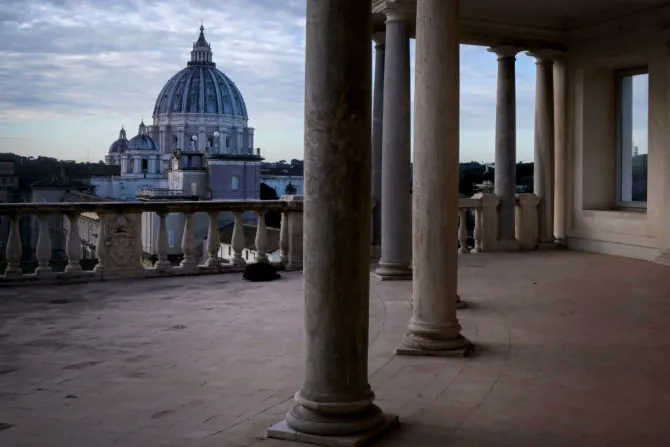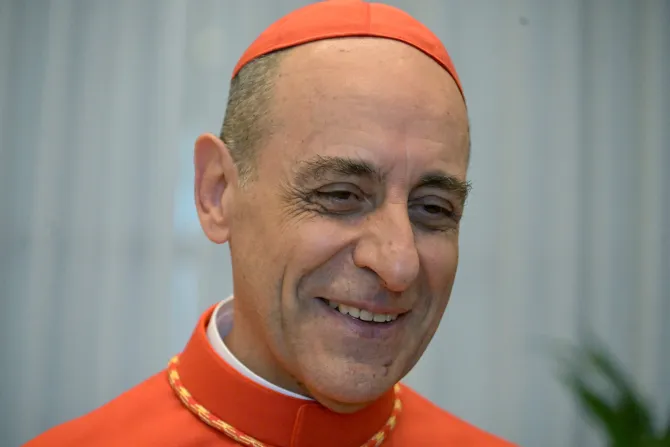The Vatican Museums on Thursday announced the new permanent exhibition of two relics purportedly belonging to St. Peter and St. John the Evangelist, shedding light on their origin and age.
The conference titled “The Tunics of St. Peter and St. John, Two Extraordinary Relics of the Sancta Sanctorum,” presented a historic overview of the two relics — a tunic of St. Peter and a dalmatic belonging to St. John the Evangelist — as well as presentations on the intensive restoration process concluded by the Tapestries and Textiles Restoration Laboratory of the Vatican Museums and the report analysis performed by the museums’ Cabinet of Scientific Research.
“The tunic with narrow sleeves, in particular, dates back to the sixth/seventh century, while the dalmatic dates back to between the end of the first and the beginning of the third century,” said Alessandro Vella, expert of Christian antiquity at the Vatican Museums, on the museum’s carbon dating analysis.
“If the tunic with narrow sleeves dates from the next years of the pontificate of Gregory the Great,” he continued, “it evidently cannot have belonged either to St. John the Evangelist nor to St. Peter, nor to any of the apostles. It would therefore be a false relic.”
But Vella noted the garments can still hold devotional value, a claim he made referencing a letter from Pope Pelagius from the middle of the sixth century on a practice “used to obtain secondary relics.”
“Any commonly used garment could be placed in contact with the venerated tomb of a saint,” he said. “At that point the robe, a tunic, specifically, left for three days at the tomb of St. Peter, would have absorbed the sanctifying virtues ‘ex contactu,’ by contact, and would in turn have become a relic if our only one was truly identifiable with the relic of St. John.”
The garments were held in the Sancta Sanctorum (Holy of Holies), a chapel located at the top of the Scala Santa (the Holy Stairs) on the inside of the original Lateran Palace, which sits adjacent to the archbasilica of St. John Lateran, the official seat of the pope as the bishop of Rome.
The Sancta Sanctorum was used to store objects of inestimable artistic and devotional values, going back to at least the middle of the eighth century, and became the private oratory of the popes. The collection included items such as the jeweled cross of Pope Sergius, relics belonging to St. Praxedes and St. Agnes, as well as the Uronica icon, an image of Christ as ruler of the universe, attributed to St. Luke.
In 1903 Pope Leo XIII allowed for scholars to enter the site to open up an investigation of the relics. But it wasn’t until 1905 that a blacksmith was able to open the two 13th-century bronze doors that enclosed the iron vault under the altar.
“The reliquaries, as well as the textiles, were transferred to the Christian Museum of the Vatican Library in 1906, then to the Vatican Museums in accordance with the rescriptum of Pope John Paul II in 1999,” explained the Patrons of the Arts in the Vatican Museums, a group dedicated to the preservation and restoration of the museums’ extensive collection of artwork.
Vella shed light on the origin of the items in the collection, noting that they are not only of great devotional value but also represent the extensive diplomatic exchange that cut across the Mediterranean world.
“The composition analyzed by scholars reveals that it was not a random collection of objects collected by pilgrims during their travels but rather diplomatic gifts exchanged between the heads of the ecclesiastical hierarchies and particularly between the popes and patriarchs of Jerusalem.”
“So these movements, these journeys, of the relics,” Vella continued, “followed official diplomatic channels, which are also attested by various other examples.”
Chronicling this historical development is important, Vella emphasized, as it offers an explanation on how the tunics arrived in the collection.
“If our tunic were truly identifiable with the relic of St. John — and there are clearly doubts that remain — this would be the origin we should attribute to it,” Vella said. “That is, it would be a garment dating back to the end of the sixth century, ritually sanctified thanks to contact with the tomb of the Evangelist John in the basilica dedicated to the saint in the city of Ephesus, Turkey, which then reached Rome and the Lateran, possibly passing through Syracuse.”
This article was originally published on Catholic News Agency.







